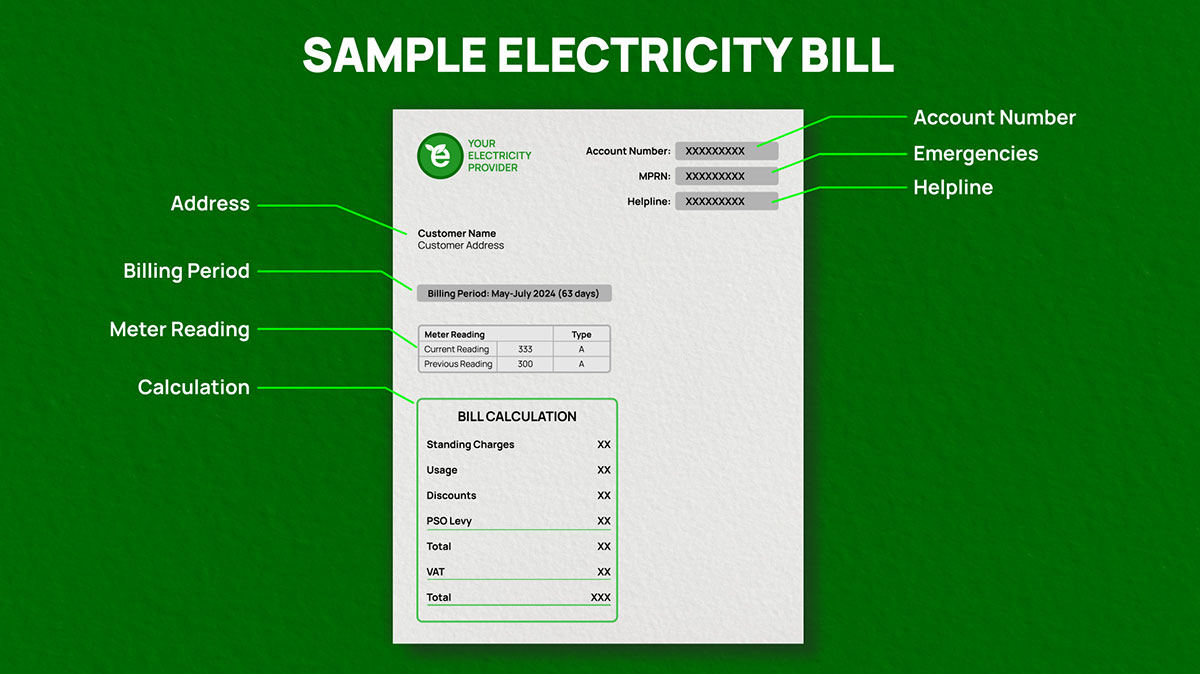How to Read Your Electricity Bill

Written by: Michael Malone
Published: October 24, 2024
Last updated: November 4, 2025
Reading time: 4 mins
Keeping an eye on your expenses can be difficult, especially when bills come in from many different places. One bill that every household has is for energy.
Keeping an eye on your bills can help you organise your finances and make informed decisions about how you consume energy.
Electricity bills can be confusing, but understanding your electricity bill is essential. This guide will explore all parts of your electricity bill, including how it is calculated.

What information is on an electricity bill?
Each electricity provider in Ireland has their own unique invoice format for their customers, but they all must contain some key pieces of information which is determined by the energy regulator – the CRU. Here is an example of the front page of a typical household electricity bill.

This front page is essentially a summary, containing all the most important details, including:
- The billing period: This shows you which months the bill relates to. The total number of days is also shown
- Cost overview: The total cost can be seen here as well as VAT and any deductions from discounts
- Account number: This is an important number usually located at the top of the bill. We recommend saving it to your phone so that it is handy should you need it at any time
- MPRN: This 11 digit number identifies your home and is needed for switching providers.
- The date the invoice was issued
- Payment due date: For the majority of customers who have a direct debit set up, this will be the date that the money
- Other information: A helpline is often included in case there are any issues with the bill
How do electricity bills work?
Energy bills in Ireland are usually issued every two months. For the vast majority of households which now have a smart meter, electricity readings are relayed automatically to ESB Networks, and they pass these accurate readings directly to the provider.
These readings are used in the cost calculation, which is determined by the type of plan you have. VAT and the PSO Levy are the same for all customers, however discounts and standing charges will vary depending on your plan. Between the summary page and page 2 of your bill, you’ll find the following information regarding costs:
- How much you have to pay and when this payment is due
- How much your last bill was
- The balance brought forward to this bill
- How many days are in the current billing period
- Any discounts that are deducted from the total
- VAT (which is 9%)
How Electricity Bills are Calculated
Electricity providers outline exactly how they came to the total electricity bill charge on each bill. How much you will pay will be determined by electricity consumption over the billing period, and the name of the plan you are currently on.
Electricity charges form the bulk of the costs (unless you have used almost no electricity). This figure is arrived at by multiplying the number of kWh you have used by the unit price of the plan you have. Any discounts are deducted from this, the PSO Levy and your standing charge is added, and then 9% VAT is added to get the overall charge.
Let’s look at an example of how your electricity supplier calculates your electricity bill.
In just over 2 months (65 days), your household consumed 333 units of electricity.The unit rate of your current plan is 0.258 cent.
333 x 0.258 = 85.91.
You have a discount for 12 months, so you save €7.30.
85.91 – 7.30 = 78.61
Let’s say the PSO Levy was €7.30 at the time, and the standing charge was €44.45.
78.61 + 6.90 + 44.45 = 129.96
When we add 9% VAT (11.70), the total is 141.66.

What is the PSO Levy?
The PSO Levy is a charge which is issued to all electricity customers in Ireland. It is determined by the Commission for the Regulation of Utilities (CRU). The charge is associated with the additional cost of sourcing renewable and sustainable energy sources. In 2024, the PSO Levy is €42.23 per year including VAT.
What is a Standing Charge?
The standing charge is a fixed fee set by your electricity supplier, which covers the cost of maintaining the electricity network and helps fund government upgrade schemes.
Meter Reading Abbreviations
Abbreviations are often used on energy bills – and they can be specific to one provider, so make sure to look at a key if there are any abbreviations. A single letter after a number can be extremely important – so pay special attention to this. Almost all homes now have a smart meter, which means most bills use accurate readings (usually indicated with an ‘a’).
An example of meter reading abbreviations on a typical electricity bill could be:
- a = actual reading
- c = customer
- e = estimated reading
- cr = credits
- p = price charge
FAQs
A kWh (kilowatt hour) is a unit of electricity, which is used to calculate your electricity consumption. The average electricity usage in Ireland is 4,200 kWh per year, or 11.5 kWh per day.
If you don’t know who your electricity supplier is, your most recent bill will display the company’s name at the top.
You will need 4 things to switch to a new electricity provider – your Meter Point Reference Number (MPRN), a recent bill and meter reading, and your bank details.
VAT on electricity in Ireland is 9% in 2024.
Your MPRN is your Meter Point Reference Number is an 11 digit code which is unique to your home. You will need this if you wish to switch to a new energy supplier.
There could be many reasons why your electricity bills are high – and the most common is that your 1 year discounted rate has expired and you are now paying a much higher rate. Switching providers can save you hundreds of euros per year.
All electricity bills are slightly different, but they all contain the same information which is determined by the Commission for the Regulation of Utilities (CRU).
It depends on your plan, however there has been a push to get more people to receive online bills in recent years, and more households are availing of this option for ease and convenience.
Electricity companies usually charge their customers every two months for electricity. This is stated clearly on the bill, along with the amount of days for which you are being charged.
How to Read Your Electricity Bill
Published: October 24, 2024
Last updated: November 4, 2025

Written by: Michael Malone
Reading time: 4mins
Keeping an eye on your expenses can be difficult, especially when bills come in from many different places. One bill that every household has is for energy.
Keeping an eye on your bills can help you organise your finances and make informed decisions about how you consume energy.
Electricity bills can be confusing, but understanding your electricity bill is essential. This guide will explore all parts of your electricity bill, including how it is calculated.

What information is on an electricity bill?
Each electricity provider in Ireland has their own unique invoice format for their customers, but they all must contain some key pieces of information which is determined by the energy regulator – the CRU. Here is an example of the front page of a typical household electricity bill.

This front page is essentially a summary, containing all the most important details, including:
- The billing period: This shows you which months the bill relates to. The total number of days is also shown
- Cost overview: The total cost can be seen here as well as VAT and any deductions from discounts
- Account number: This is an important number usually located at the top of the bill. We recommend saving it to your phone so that it is handy should you need it at any time
- MPRN: This 11 digit number identifies your home and is needed for switching providers.
- The date the invoice was issued
- Payment due date: For the majority of customers who have a direct debit set up, this will be the date that the money
- Other information: A helpline is often included in case there are any issues with the bill
How do electricity bills work?
Energy bills in Ireland are usually issued every two months. For the vast majority of households which now have a smart meter, electricity readings are relayed automatically to ESB Networks, and they pass these accurate readings directly to the provider.
These readings are used in the cost calculation, which is determined by the type of plan you have. VAT and the PSO Levy are the same for all customers, however discounts and standing charges will vary depending on your plan. Between the summary page and page 2 of your bill, you’ll find the following information regarding costs:
- How much you have to pay and when this payment is due
- How much your last bill was
- The balance brought forward to this bill
- How many days are in the current billing period
- Any discounts that are deducted from the total
- VAT (which is 9%)
How Electricity Bills are Calculated
Electricity providers outline exactly how they came to the total electricity bill charge on each bill. How much you will pay will be determined by electricity consumption over the billing period, and the name of the plan you are currently on.
Electricity charges form the bulk of the costs (unless you have used almost no electricity). This figure is arrived at by multiplying the number of kWh you have used by the unit price of the plan you have. Any discounts are deducted from this, the PSO Levy and your standing charge is added, and then 9% VAT is added to get the overall charge.
Let’s look at an example of how your electricity supplier calculates your electricity bill.
In just over 2 months (65 days), your household consumed 333 units of electricity.The unit rate of your current plan is 0.258 cent.
333 x 0.258 = 85.91.
You have a discount for 12 months, so you save €7.30.
85.91 – 7.30 = 78.61
Let’s say the PSO Levy was €7.30 at the time, and the standing charge was €44.45.
78.61 + 6.90 + 44.45 = 129.96
When we add 9% VAT (11.70), the total is 141.66.

What is the PSO Levy?
The PSO Levy is a charge which is issued to all electricity customers in Ireland. It is determined by the Commission for the Regulation of Utilities (CRU). The charge is associated with the additional cost of sourcing renewable and sustainable energy sources. In 2024, the PSO Levy is €42.23 per year including VAT.
What is a Standing Charge?
The standing charge is a fixed fee set by your electricity supplier, which covers the cost of maintaining the electricity network and helps fund government upgrade schemes.
Meter Reading Abbreviations
Abbreviations are often used on energy bills – and they can be specific to one provider, so make sure to look at a key if there are any abbreviations. A single letter after a number can be extremely important – so pay special attention to this. Almost all homes now have a smart meter, which means most bills use accurate readings (usually indicated with an ‘a’).
An example of meter reading abbreviations on a typical electricity bill could be:
- a = actual reading
- c = customer
- e = estimated reading
- cr = credits
- p = price charge
FAQs
A kWh (kilowatt hour) is a unit of electricity, which is used to calculate your electricity consumption. The average electricity usage in Ireland is 4,200 kWh per year, or 11.5 kWh per day.
If you don’t know who your electricity supplier is, your most recent bill will display the company’s name at the top.
You will need 4 things to switch to a new electricity provider – your Meter Point Reference Number (MPRN), a recent bill and meter reading, and your bank details.
VAT on electricity in Ireland is 9% in 2024.
Your MPRN is your Meter Point Reference Number is an 11 digit code which is unique to your home. You will need this if you wish to switch to a new energy supplier.
There could be many reasons why your electricity bills are high – and the most common is that your 1 year discounted rate has expired and you are now paying a much higher rate. Switching providers can save you hundreds of euros per year.
All electricity bills are slightly different, but they all contain the same information which is determined by the Commission for the Regulation of Utilities (CRU).
It depends on your plan, however there has been a push to get more people to receive online bills in recent years, and more households are availing of this option for ease and convenience.
Electricity companies usually charge their customers every two months for electricity. This is stated clearly on the bill, along with the amount of days for which you are being charged.
Solar Energy Saves Households Thousands in Electricity Costs
Take our 2-minute questionnaire and find affordable solar options to suit your budget and lifestyle.


